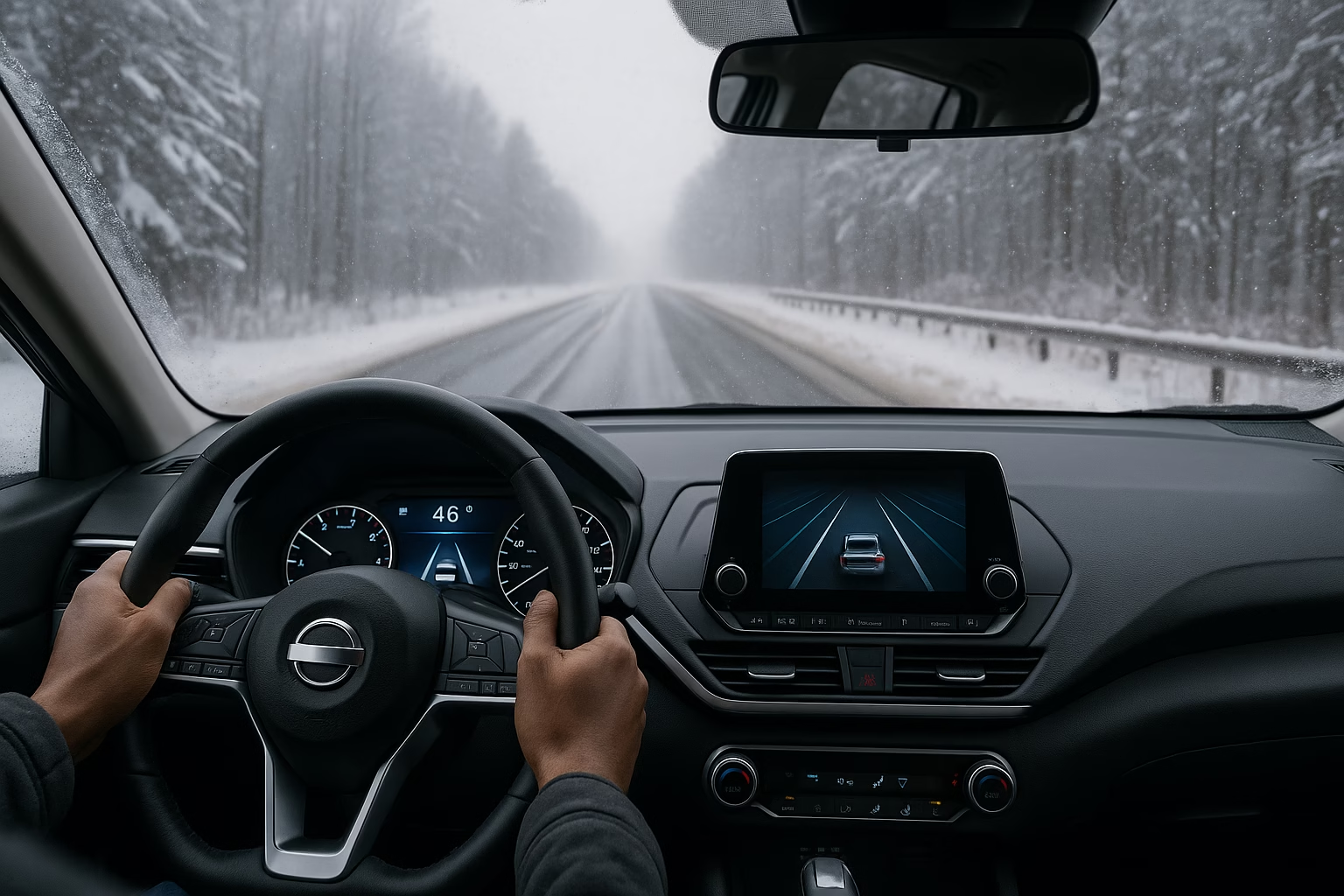Your car’s advanced driver assistance systems rely on cameras, radar, lidar and other sensors to see the road around you. Like your own eyes, these sensors can struggle when the weather or road surface gets rough. If you have ever noticed your adaptive cruise control switching off in a downpour or your lane keeping warning flashing on a foggy morning, you have experienced the limits of technology. Understanding how environmental conditions affect ADAS performance helps you anticipate problems and stay safe.
Rain and spray
Heavy rain is one of the most common causes of ADAS interruptions. Cameras need a clear view of lane markings and objects ahead. When water droplets collect on the windscreen or the protective cover of a forward-facing camera, the image becomes blurry. Radar can penetrate rain better but still has reduced range in a downpour. Spray from vehicles ahead can have a similar effect, coating sensors with dirty water and blocking their view. During heavy rain, you may see warnings that adaptive cruise control, lane keeping assist or automatic emergency braking are limited or unavailable. Clean your windscreen and sensor areas regularly and keep washer fluid topped up. Slow down and leave extra space, as you can no longer rely on the system to maintain distance or keep you in your lane.
Fog, smoke and dust
Fog, smoke and dust storms scatter light and make it difficult for cameras and lidar to see lane markings and hazards. Radar is less affected but still struggles to identify smaller objects. Many systems will alert you that visibility is poor and disengage features like lane keep and traffic sign recognition. In thick fog or smoke, reduce your speed and increase your following distance. Use your headlights and fog lights appropriately so other drivers can see you. Remember that ADAS features are not a replacement for careful driving in low visibility.
Snow and ice
Snow and ice create two problems for ADAS: obstruction and confusion. Snow can cover cameras and radar sensors, rendering them blind. It can also hide lane markings and road edges, which lane departure and lane keeping systems rely on. Even if the sensor view is clear, the algorithms may misinterpret a snowbank as a solid object or fail to see a snow-covered vehicle. Ice and slush can accumulate on sensors, causing them to malfunction or turn off. If your vehicle has a grille-mounted radar sensor, check that snow and ice are cleared before driving. In areas that experience winter conditions, consider the positioning of sensors when removing snow from your car. Use the defroster and heated mirrors to help clear moisture.
Glare and bright sunlight
Strong sunlight can overwhelm camera sensors, especially when driving directly into the sun at dawn or dusk. Glare off the road surface or vehicles can cause the camera to wash out, making it difficult to detect lane lines or vehicles ahead. This can trigger false warnings or disable features. Keeping your windscreen clean and using the sun visor helps reduce glare. Some vehicles have polarising filters on cameras to cut down on reflections, but they are not foolproof. When you know you will be driving towards low sun, be prepared for your ADAS to behave differently and reduce your reliance on it.
Dirty sensors and windscreen
Mud, bugs, salt and road grime can cover cameras, radar modules and ultrasonic sensors. A thin film of dirt may not be obvious to you but can distort the view of the sensor. Regularly cleaning your vehicle’s cameras, bumper covers and windscreen ensures they function correctly. Avoid using harsh chemicals on camera lenses or radar covers; warm water and a soft cloth are usually sufficient. Some vehicles come with built-in lens washers for the camera but they only work if the washer fluid reservoir is full. Don’t forget to clean side cameras and sensors on mirrors, as blind spot monitoring and parking assistants rely on them.
Road surface and markings
Lane keeping and lane centring assistance depend on clear lane markings. Poorly painted or faded lines, temporary road works, gravel shoulders or unusual lane layouts can confuse the system. You might find the steering wheel vibrating or the lane assist warning flashing even when you are within your lane, simply because the camera cannot see the lines. On roads without marked lanes, these systems may not work at all. Adaptive cruise control can also behave unpredictably on hilly or undulating roads, as radar beams may point toward the sky or the ground at certain angles. Understanding your route and the road quality helps you anticipate when ADAS might struggle.
Potholes and rough surfaces
Potholes and rough road surfaces can affect both sensors and vehicle dynamics. Sudden jolts may cause a camera to shake momentarily out of alignment, causing a misreading or false alert. If your vehicle has active suspension or steering assistance, hitting a pothole could cause the system to disengage temporarily for safety. Avoid potholes where possible and have your alignment checked if you hit a severe one, as misaligned wheels can compromise lane keeping accuracy and overall handling.
Road spray and standing water
Deep puddles and standing water can cause the vehicle to hydroplane, reducing steering and braking control. If ADAS sensors detect wheel slip or loss of traction, they may disengage to avoid giving incorrect inputs. Keep a firm grip on the wheel when driving through water and let the car slow down. Large splashes can also temporarily blind sensors with a sheet of water. Once you are through, check that all systems have re-engaged and continue cautiously.
Heat and extreme cold
Extreme temperatures can affect the electronics that power ADAS sensors. Very high heat may cause cameras to overheat, prompting them to shut down temporarily to prevent damage. Extreme cold can slow down electronic responses or cause condensation inside sensor housings. While manufacturers test systems in various climates, there are limits. If you see repeated sensor errors in very hot or very cold weather, consult your dealer. Parking your vehicle in the shade or a garage can help protect sensitive equipment.
What drivers can do
The best way to keep ADAS working well in all conditions is to treat it as a support tool rather than a guarantee. Here are practical steps you can take:
- Inspect sensors regularly. Before long trips, check that cameras, radar covers and parking sensors are clean and unobstructed. Remove ice, snow or mud and wipe away grime.
- Stay aware of the weather. Pay attention to forecasts and road reports. If heavy rain, fog or snow is expected, plan extra time and be ready for your ADAS to disengage.
- Understand the messages. Modern vehicles display messages or icons when a system is limited or inactive. Learn what these alerts mean and don’t ignore them. When in doubt, consult your manual.
- Maintain your tyres and suspension. Proper tyre pressure and alignment help ADAS sensors work correctly and ensure that the vehicle responds predictably when you need to take over.
- Drive to the conditions. Slow down in poor weather, increase your following distance and keep both hands on the wheel. If a safety feature switches off, assume full control and adapt your driving accordingly.
By understanding how weather and road conditions affect ADAS performance, you can use your vehicle’s safety features more effectively. Advanced driver assistance systems are designed to make driving easier and safer, but they have limitations. Staying informed, keeping your car well maintained and remaining attentive at all times will help you get the most out of the technology without being caught off guard when nature throws you a curveball.

Hiran Alwis is an automotive lecturer and ADAS specialist with over 15 years of experience in diagnostics, advanced safety systems, and technical training. He founded ADAS Project to help everyday drivers and workshop technicians understand and safely use advanced driver assistance systems.
